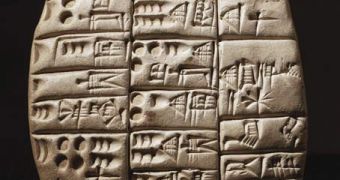On the left bank of the Euphrates River, 100 km (60 mi) of Aleppo (Syria), in the archaeological site of Jerf el-Ahmar (in Arabian "Red Bank"), a Syrian-French team discovered, in 1996, some very odd stone slates bearing engraved graphics.
The plates were considered to date from the Neolithic (New Stone Age), being 9,000 years old! The plates pre-date with 4,000 years the oldest previously known writing, the Sumerian (in southern Iraq), believed to have appeared 5,000 years ago.
The mysterious graphics combine or associate animal figures (quadrupeds or prey birds) with abstract signs: a sinuated line ended on an arrow or a cross. People were known to have used previously to that date animal figures or abstract signs, but now they were discovered for the first time associated in various compositions, making what researchers call pictograms: mnemotechnical (memory involving) representations, a kind of graphic resume alluding to a story. There may not represent proper writing, which is always the linguistic formulation of a structured thinking, but these plates forecasted the Sumerian writing.
Decoding those plates could be impossible, as there is not a "Rossette stone" like that employed by Champollion to decode the Egyptian hieroglyphs.
Scientists consider that the first sketches of a graphic system appeared when a civilization reached an economic and intellectual level that made necessary the need to fix, in a way or another, the actual facts of daily life but also the abstract ones, linked to concepts and beliefs.
As a phenomenon, the writing is not unique in time and space. Writing systems were spontaneous phenomena, most of them independent one of another, in various points of the world at various times.
The first stage was that of primitive signs, isolated marks, made spontaneously, as notches, knots or lines, sometimes even as sketches, announcing the first pictograms. These signs characterize the hunters-gatherers - like the Paleolithic (old stone age) cave wall paintings -, but they are still being employed today by some Amerindians of South America or Australian Aborigines.
The second stage is that of the symbolic writing: sketches are more complex, encoding messages. Walking can be expressed by two walking feet, giving by an extended hand, and so on. This stage is characteristic for agricultural societies and expresses a new attitude toward the Universe, being correlated with the first religious representations. Agriculture emerged and spread in the Middle East 9,000 years ago (exactly the place and age of the Jerf el-Ahmar plates) and spread to Danube valley around 7,500 years ago and to the western Europe 7,300 years ago.
The thirds stage in the development of the writing passes through the urban revolution of Sumer and Egypt, in a hierarchical social organization and booming economy, when the ideographic writing appeared: the Sumerian cuneiform writing and the Egyptian hieroglyphs.
The fourth stage is represented by the alphabetical writing. The oldest known alphabet is the Phoenician, dated 3,500 years ago, and Ugaritic, on the Syrian coast.

 14 DAY TRIAL //
14 DAY TRIAL //